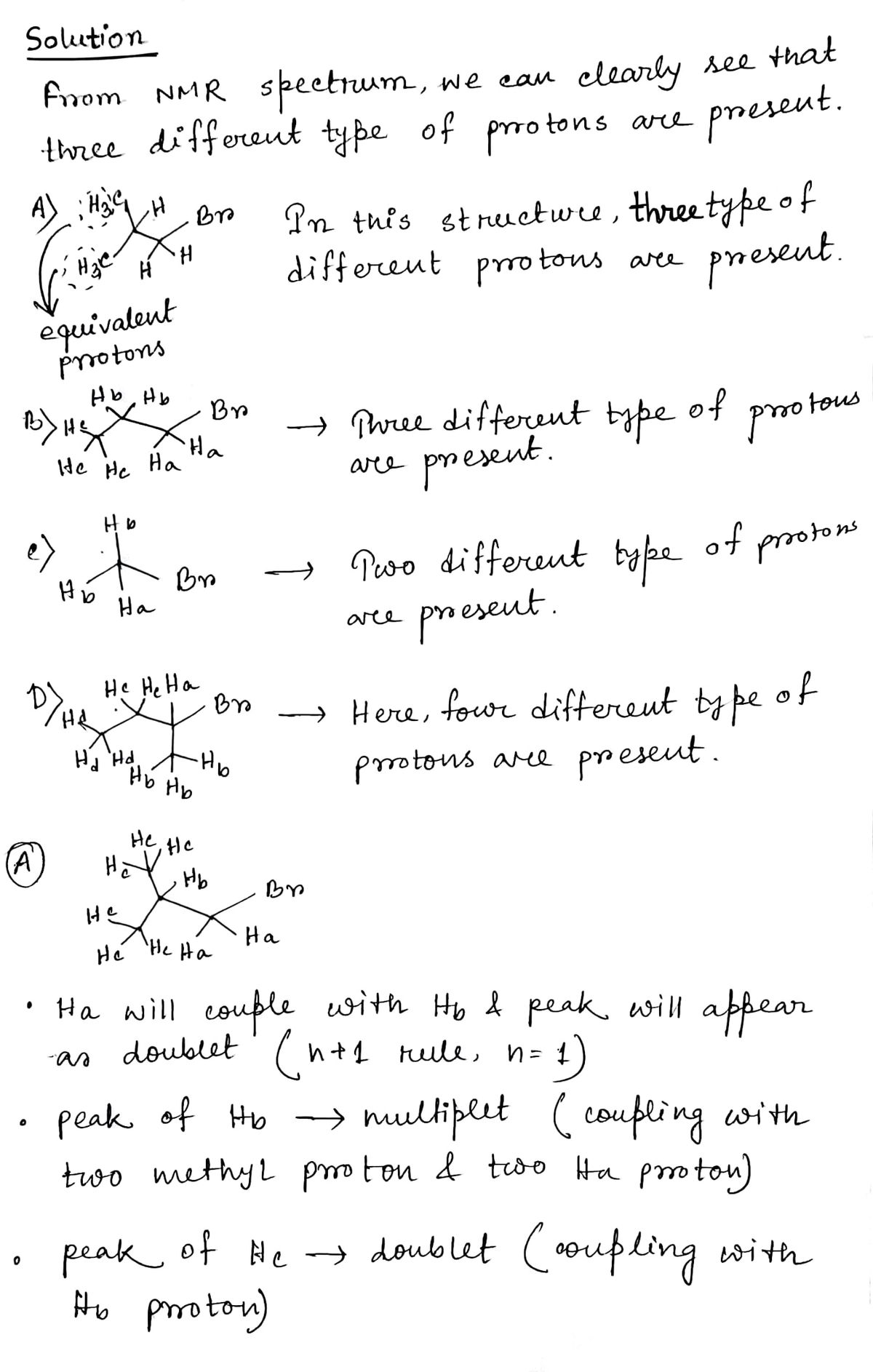Chemistry
10th Edition
ISBN:9781305957404
Author:Steven S. Zumdahl, Susan A. Zumdahl, Donald J. DeCoste
Publisher:Steven S. Zumdahl, Susan A. Zumdahl, Donald J. DeCoste
Chapter1: Chemical Foundations
Section: Chapter Questions
Problem 1RQ: Define and explain the differences between the following terms. a. law and theory b. theory and...
Related questions
Question
100%
Which structure is most consistent with the proton NMR spectrum shown below?

Transcribed Image Text:The image presents a proton nuclear magnetic resonance (NMR) spectrum with its chemical shift in parts per million (PPM) along the x-axis ranging from 4 to 0. This NMR spectrum is likely for an organic compound containing bromine, displayed alongside four structural isomers marked as A, B, C, and D.
**Spectrum Details:**
1. **Chemical Shift Values:**
- There are prominent peaks around the chemical shifts of 1 PPM, 2 PPM, and slightly above 3 PPM.
- Each peak represents a unique chemical environment of hydrogen in the compound.
2. **Peak Analysis:**
- The peak at approximately 1 PPM could indicate the presence of a methyl group.
- The peak around 2 PPM might suggest hydrogens adjacent to bromine (an electron-withdrawing group).
- The peak just above 3 PPM could be indicative of hydrogens attached to carbons next to a brominated carbon.
**Structural Isomers:**
- **A**: Represents a structure where bromine is attached to the terminal carbon of a propyl group.
- **B**: Displays bromine connected to the middle carbon of a propyl linkage.
- **C**: Shows a similar propyl structure with bromine on the middle carbon, potentially suggesting identical symmetry with B.
- **D**: Indicated where bromine is again bound to the middle carbon.
Understanding the alignment of these peaks with specific isomers can help in determining the correct structure based on the NMR spectrum analysis. This correlation is essential for structural elucidation in organic chemistry.
Expert Solution
Step 1

Step by step
Solved in 2 steps with 2 images

Knowledge Booster
Learn more about
Need a deep-dive on the concept behind this application? Look no further. Learn more about this topic, chemistry and related others by exploring similar questions and additional content below.Recommended textbooks for you

Chemistry
Chemistry
ISBN:
9781305957404
Author:
Steven S. Zumdahl, Susan A. Zumdahl, Donald J. DeCoste
Publisher:
Cengage Learning

Chemistry
Chemistry
ISBN:
9781259911156
Author:
Raymond Chang Dr., Jason Overby Professor
Publisher:
McGraw-Hill Education

Principles of Instrumental Analysis
Chemistry
ISBN:
9781305577213
Author:
Douglas A. Skoog, F. James Holler, Stanley R. Crouch
Publisher:
Cengage Learning

Chemistry
Chemistry
ISBN:
9781305957404
Author:
Steven S. Zumdahl, Susan A. Zumdahl, Donald J. DeCoste
Publisher:
Cengage Learning

Chemistry
Chemistry
ISBN:
9781259911156
Author:
Raymond Chang Dr., Jason Overby Professor
Publisher:
McGraw-Hill Education

Principles of Instrumental Analysis
Chemistry
ISBN:
9781305577213
Author:
Douglas A. Skoog, F. James Holler, Stanley R. Crouch
Publisher:
Cengage Learning

Organic Chemistry
Chemistry
ISBN:
9780078021558
Author:
Janice Gorzynski Smith Dr.
Publisher:
McGraw-Hill Education

Chemistry: Principles and Reactions
Chemistry
ISBN:
9781305079373
Author:
William L. Masterton, Cecile N. Hurley
Publisher:
Cengage Learning

Elementary Principles of Chemical Processes, Bind…
Chemistry
ISBN:
9781118431221
Author:
Richard M. Felder, Ronald W. Rousseau, Lisa G. Bullard
Publisher:
WILEY